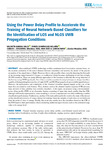Mostrar o rexistro simple do ítem
Using the Power Delay Profile to Accelerate the Training of Neural Network-Based Classifiers for the Identification of LOS and NLOS UWB Propagation Conditions
| dc.contributor.author | Barral Vales, Valentín | |
| dc.contributor.author | Domínguez-Bolaño, Tomás | |
| dc.contributor.author | Escudero, Carlos J. | |
| dc.contributor.author | García-Naya, José A. | |
| dc.date.accessioned | 2024-03-04T17:42:04Z | |
| dc.date.available | 2024-03-04T17:42:04Z | |
| dc.date.issued | 2020 | |
| dc.identifier.citation | V. B. Vales, T. Domínguez-Bolaño, C. J. Escudero and J. A. García-Naya, "Using the Power Delay Profile to Accelerate the Training of Neural Network-Based Classifiers for the Identification of LOS and NLOS UWB Propagation Conditions," in IEEE Access, vol. 8, pp. 220205-220214, 2020, doi: 10.1109/ACCESS.2020.3043503. | es_ES |
| dc.identifier.issn | 2169-3536 | |
| dc.identifier.uri | http://hdl.handle.net/2183/35782 | |
| dc.description.abstract | [Abstract]: Ultra-wideband (UWB) technology enables centimeter-level localization systems based on the accurate estimation of the actual distance between transmitter and receiver, by means of the precise estimation of the signal time-of-flight. However, this is only possible when correctly detecting the first path of the incoming signal instead of a bounce or a reflection, which becomes challenging in non line-of-sight (NLOS) situations. There are many different approaches in the literature to alleviate the wrong detection of the first incoming UWB signal path. One of them considers machine learning techniques to design classifiers capable of distinguishing between line-of-sight (LOS) and NLOS propagation from available signal features. However, the performance and complexity of the obtained classifiers depend largely on the size of the input data associated to such features. Thus, features such as the channel impulse response (CIR) produce large amounts of data, yielding very complex classifiers. In this paper, we propose using a downsampled power delay profile (PDP) as an alternative feature consisting of input data much smaller than the CIR, although sufficiently representative, hence resulting in a lower computational cost while exhibiting a similar classification performance. Furthermore, another of the tasks addressed in this work is the study of the impact on the classification results of using a dataset for training where the samples of each class are not balanced from the point of view of energy. Finally, this work also studies how the classifiers based on the CIR or the PDP improve their performance when considering additional signal features such as the estimated range value or its energy level. | es_ES |
| dc.description.sponsorship | This work was supported in part by the Xunta de Galicia under Grant ED431C 2020/15 and Grant ED431G2019/01 to support the Centro de Investigación de Galicia, Centro de Investigación en Tecnologías de la Información y las Comunicaciones (CITIC), in part by the Agencia Estatal de Investigación of Spain under Grant RED2018-102668-T and Grant PID2019-104958RB-C42, and in part by the European Regional Development Fund of the EU under Grant FEDER Galicia 2014-2020 & AEI/FEDER Programs, UE. | es_ES |
| dc.description.sponsorship | Xunta de Galicia; ED431C 2020/15 | es_ES |
| dc.description.sponsorship | Xunta de Galicia; ED431G2019/01 | es_ES |
| dc.language.iso | eng | es_ES |
| dc.publisher | Institute of Electrical and Electronics Engineers | es_ES |
| dc.relation | info:eu-repo/grantAgreement/AEI/Plan Estatal de Investigación Científica y Técnica y de Innovación 2017-2020/RED2018-102668-T/ES/RED COMONSENS/ | es_ES |
| dc.relation | info:eu-repo/grantAgreement/AEI/Plan Estatal de Investigación Científica y Técnica y de Innovación 2017-2020/PID2019-104958RB-C42/ES/AVANCES EN CODIFICACIÓN Y PROCESADO DE SEÑAL PARA LA SOCIEDAD DIGITAL | es_ES |
| dc.relation.uri | https://doi.org/10.1109/ACCESS.2020.3043503 | es_ES |
| dc.rights | Atribución 4.0 Internacional | es_ES |
| dc.rights.uri | http://creativecommons.org/licenses/by/3.0/es/ | * |
| dc.subject | Channel impulse response | es_ES |
| dc.subject | Power delay profile | es_ES |
| dc.subject | Convolutional neural network | es_ES |
| dc.subject | Deep learning | es_ES |
| dc.subject | Indoor localization | es_ES |
| dc.subject | Non line-of-sight | es_ES |
| dc.subject | Ultra-wideband | es_ES |
| dc.subject | Ranging | es_ES |
| dc.subject | Received signal strength | es_ES |
| dc.title | Using the Power Delay Profile to Accelerate the Training of Neural Network-Based Classifiers for the Identification of LOS and NLOS UWB Propagation Conditions | es_ES |
| dc.type | info:eu-repo/semantics/article | es_ES |
| dc.rights.access | info:eu-repo/semantics/openAccess | es_ES |
| UDC.journalTitle | IEEE Access | es_ES |
| UDC.volume | 8 | es_ES |
| UDC.startPage | 220205 | es_ES |
| UDC.endPage | 220214 | es_ES |
| dc.identifier.doi | 10.1109/ACCESS.2020.3043503 |
Ficheiros no ítem
Este ítem aparece na(s) seguinte(s) colección(s)
-
GI-GTEC - Artigos [193]






